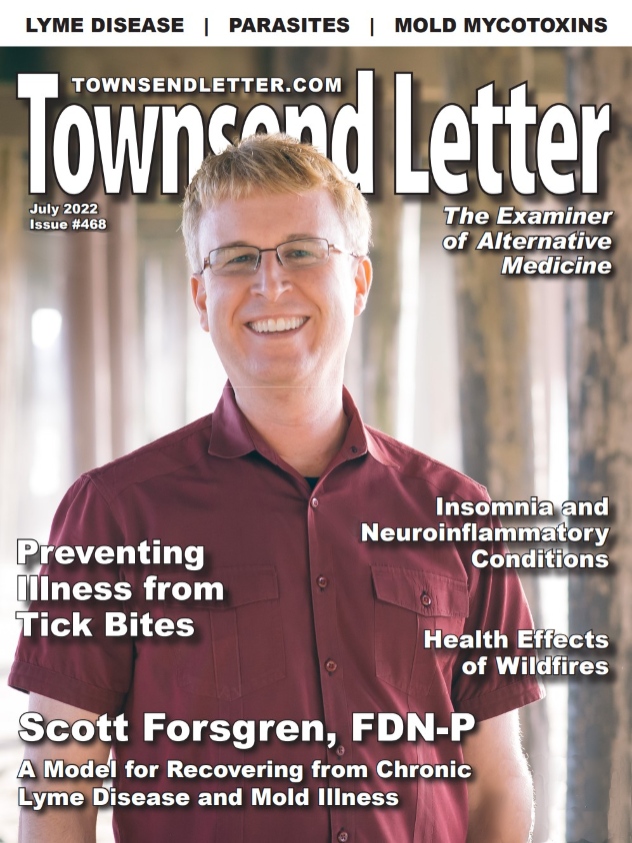By Jill Carnahan, MD
As climate change continues to evolve, we’ve seen an increase in unpredictable wildfires that seem to grow larger and burn hotter each year. With this increase in disastrous wildfires comes another quandary—a radical spike in air pollution that causes a multitude of health complications in both the short-term and long-term.
These fires roar through acres of wilderness, farmland, and man-made structures. This creates billowing plumes of smoke that engulf surrounding areas near and far. We inevitably inhale this smoke that’s chock-full of noxious gas, charred plant material, toxic synthetic materials, and other chemical-laden particulates.
This cocktail of incinerated toxins and particles is well-documented to be severely detrimental—especially to those with existing respiratory conditions or those with prolonged exposure. To make matters worse, more and more research is finding that this toxic haze may also be loaded with another concerning component—microscopic mold spores.
As clinicians at the forefront of root-cause medicine, we’re seeing an influx of patients being affected by this surge of environmental toxins after a wildfire strikes. And if recent years are any indication of what the future holds, it’s safe to assume that air pollution and subsequent illnesses triggered by these wildfires will continue to be a growing concern.
As practitioners we must continue to educate ourselves in our increasingly toxic world so we can best fulfill our roles as facilitators of healing. Fortunately, we are making great strides in understanding the link between wildfires, environmental-related illnesses, and how we can best treat patients dealing with these complex and life-altering conditions.
Toxins Contained Within Wildfire Smoke
When a wildfire strikes, it can and will engulf anything unlucky enough to be in its path – indiscriminately incinerating wilderness, trees, crops, and a slew of man-made structures. As smoke, soot, and ashes are released into the air, so are a cocktail of man-made chemicals and volatile organic compounds (VOCs), including the following:1-3
- Aldehydes
- Acid gasses
- Benzene
- Dioxins
- Ethylene glycol
- Formaldehyde
- Heavy metals
- Methylene chloride
- Nitrogen oxides
- Petroleum hydrocarbons
- Polycyclic aromatic hydrocarbons (PAHs)
- Styrene
- Sulfur dioxide
- Tetrachloroethylene
- Toluene
- Xylene
It’s estimated that wildfire smoke and the particulate matter that comes with it, now accounts for up to half of all fine-particle pollution in the western United States.4 The particulates contained within wildfire smoke linger long after the fire has been extinguished—becoming suspended in the air and drifting miles away from their source—making declining air quality a concern across the globe.
Health Effects Associated With Exposure to Wildfire Smoke
Elevated or prolonged exposure to the organic particles within smoke as well as the toxic VOCs it contains can trigger:
- Increased endothelium inflammation
- Recruitment of macrophages and white blood cells
- Autonomic dysregulation in cardiac function
- Increased oxidative stress leading to depletion of antioxidants
- Cytokine release, leading to systemic vascular inflammation and subsequent increased risk for vascular disease
This can lead to a range of symptoms and conditions ranging from mild to serious. And if not addressed, the damage can spiral into life-altering or even life-threatening conditions. Health effects may include:5-7
- Irritation of the eyes, nose, and/or throat
- Headaches and dizziness
- Loss of coordination
- Nausea and/or vomiting
- Worsening of asthma symptoms
- Increased risk for the development of asthma and respiratory illness (including COPD)
- Difficulty breathing
- Fatigue
- Cancer
- Damage to the liver and/or kidneys
- Damage to the central nervous system
- Increased susceptibility to viral and bacterial infections—especially respiratory infections
- Increased risk of premature birth and/or low birth weights
- An increased risk of neurodegenerative diseases like dementia and Alzheimer’s
- A decrease in respiratory, cardiovascular, and neurological function in adults and children—exposure has been found to be particularly detrimental to developing children
- Suppression of immune function and regulation
And to further complicate matters, there is mounting evidence that the particulates found drifting through the air after a fire can also contain mind-bending levels of bacteria, fungi, and toxic mold spores.
The Link Between Wildfires
and Toxic Mold Exposure
As wildfires roar through a region, the fire’s heat propels everything it ignites up into the air. And as firefighting crews employ bulldozers and hand tools in an attempt to halt advancing flames, an array of compounds are churned up—making their way into our atmosphere. Among these compounds are a multitude of bacteria and fungi. As these bacteria and fungi are whisked skyward, they attach to floating particulate matter—hitching a ride into the air and eventually into our lungs.8,9
The fact that wildfire smoke not only contains poisonous gasses and charred materials but also pathogens raises a whole new slew of health-related concerns. This is particularly troublesome considering how exposure to wildfire smoke suppresses the immune system and compromises the respiratory system’s natural defense mechanisms. This creates the perfect storm that allows these fungal spores to penetrate directly into the body.
While recent studies have revealed that wildfire smoke and its particulates do in fact contain copious amounts of living organisms—including toxic fungal species—we still have more questions than answers. More time and research are needed to truly grasp the complex nature of the microbial ecosystem within wildfire smoke and its overall effects on the environment and human health.
But understanding potential contaminants within wildfire smoke can help us, as clinicians, identify our most vulnerable patients, pinpoint underlying triggers, and create comprehensive treatment plans.
Vulnerable Populations
While exposure to wildfire smoke and its detrimental components poses a risk to anyone, there are certain individuals at greater risk of experiencing more severe and adverse health effects. These vulnerable populations include:
- The very young and the elderly
- People who work outdoors and/or in close proximity to wildfires
- Pregnant women
- Those who have an underlying respiratory condition like asthma, chronic obstructive pulmonary disease (COPD), or chronic bronchitis
- Individuals with an underlying cardiac condition like congestive heart failure (CHF), angina, or ischemic heart disease
- Those with a diagnosis of diabetes since this disease impairs cardiovascular and immune function
Individuals with specific genetic polymorphisms are also predisposed to a more exaggerated response to wildfire smoke. These genetic polymorphisms include10:
- Certain SNPs: The following single nucleotide polymorphism (SNPs) genes all play a strong role in pulmonary response to air pollution:
- TNF-alpha
- GSTM1
- GSTP1
- NQO1
- TLR4
- NRF2 SOD2
- GSTM1 gene deletion: Deletion of this gene increases the risk for inflammatory lung response to fire smoke and ozone. It has also been shown to increase sensitivity to particulate matter, as evidenced by greater changes in heart rate variability.
Getting a clear picture of a patient’s potential susceptibility to wildfire smoke exposure can help us better understand how to treat them.
Treating Patients Exposed to Wildfire Smoke and Potential Mold Spores
The interplay between environmental toxins and the exacerbation of chronic illnesses makes environmentally triggered illnesses inherently challenging to diagnose and treat. Fortunately, when it comes to conditions that are caused or exacerbated by exposure to toxic wildfire smoke and potential mold and fungal spores, there are some simple steps that can drastically minimize exposure.
When encountering patients with suspected or known wildfire smoke-related illnesses, it’s best to take a three-pronged approach of addressing exposure, detoxing, and promoting holistic whole-life healing.
Address Exposure
Particulate matter and the toxic chemicals and microbes contained within them float through the air, settle on surfaces, and deposit themselves in our soil, water, crops, and homes. This makes the after-effects of wildfires a wider concern than simply focusing on air quality.
Before a treatment protocol can be truly effective, it’s critical to address sources of exposure to minimize further exposure. We can do this by educating patients on the importance of taking the following steps.
Protection From Additional Exposure: Removing post-fire toxic residue that has settled within patients’ homes and/or businesses is crucial. Educate patients on the importance of deep cleaning all surfaces:
- Vacuuming carpets, rugs, drapes, and furniture
- Mopping tile, laminate, hardwood, and other floorings
- Wiping down all countertops and walls
During the process of cleaning and eliminating post-fire smell and residue, it’s imperative for patients to take precautionary measures by wearing:
- A well-fitted NIOSH-certified mask (like an N95 mask) or respirator to protect their airways
- Gloves
- Safety goggles
- Long-sleeved shirts and long pants
- Shoes with socks
Removing these deposits of toxic particulates is essential for any of the subsequent steps to be effective.
Addressing Indoor Air Quality: Encourage patients to replace their HVAC filters and have HVAC ducts cleaned out. Incorporating an air purification system that utilizes a high-efficiency particulate air (HEPA) filter is a powerful tool to help trap any lingering particles and VOCs floating around.
While many excellent air purification systems are available for purchase, studies conducted by the EPA (Environmental Protection Agency) have found that at-home, DIY air cleaning systems effectively reduce moderate smoke concentrations to near zero. They also have a clean air delivery rate that’s comparable to a small commercial air cleaner. Patients can be directed to resources to build their own DIY at-home air filters with a Corsi-Rosenthal box that requires the following simple materials:
- A total of four 20-inch x 20-inch MERV 13 air filters
- A 20-inch box fan
- Two 20-inch x 20-inch cardboard boxes
- A roll of duct tape
As clinicians, patient education is one of our core duties. Educating our patients on the importance of addressing potential exposure within their homes is foundational for treatment and cannot be overemphasized.
Addressing Water Quality: As soot settles, it makes its way into the waterways—making the already questionable tap-water a toxic soup. And as wildfires decimate trees and vegetation, there’s a massive spike in sediment that gets washed into our waterways further contaminating drinking water.
We can help dramatically reduce our patients’ exposure to environmental toxins by educating them on the importance of filtering water and directing them to evidence-based resources and products.
Enhance Detoxification
Even with the best of air purification and water filtration systems, during and after a fire, exposure to particles, toxins, and microbes is inevitable. A critical part of detoxification protocol is supplementation. This aids the body in eliminating toxins and pathogens while reversing damage and enhancing healing. The specific supplementation protocol that has been proven to aid in addressing exposure to wildfire is outlined below:11-17
- Folic acid + Vitamin B6 + Vitamin B12: A combination of 2.5 mg/d folic acid, 50 mg/d vitamin B6, and 1 mg/d vitamin B12. Studies have found that if given for four weeks, this trio significantly reduces the inflammatory effects of smoke inhalation.
- Omega-3 fatty acids EPA and DHA: 1.6 grams of EPA and DHA taken once daily can help stabilize heart rate variability seen after smoke inhalation.
- Vitamin C + Vitamin E: A combination of vitamin C (up to 500 mg daily) and vitamin E (up to 800 IU daily) has been shown to decrease airway irritation and improve airflow in children and adults after ozone exposure.
- Sulforaphane: 30-50 mg of sulforaphane per day for adults can help enhance antioxidant levels and fast-track toxin excretion.
- N-acetyl cysteine (NAC): NAC (typical adult dose 1800 mg/d) can help reduce lung inflammation by blocking pro-inflammatory cytokine production.
- Detox binders: Detox binders are designed to safely trap toxins in the digestive tract for safe elimination from the body.
- Glutathione: Glutathione is the body’s primary endogenous antioxidant—making it a key player in accelerating detoxification.
In addition to supplementation, accompanying detoxification strategies can help expedite the detoxification of pollutants absorbed via wildfire particulates. Adjunct detoxification methods include:
- Infrared saunas
- IV detoxification therapy
- Dry brushing
- Epsom salt baths
- Mineral or alkaline waters
As partners in our patients’ healing, it’s important to personalize a detoxification plan best suited to each individual’s needs.
Promote Mental, Emotional, and Financial Well-Being
While the physical effects of a natural disaster like a wildfire can be devastating, there’s also a significant amount of mental, emotional, and financial turmoil that can turn our patients’ worlds upside down. And as clinicians, it’s our responsibility to address patient well-being from a holistic perspective—because true healing and health encompass much more than just their physical state. Here’s what you can do to help your patients cope:
- Encourage them to process their emotions and acknowledge that they’ve been through a traumatic experience. In some cases, it may be helpful to direct them to clinicians who specialize in mental health and trauma processing.
- Emphasize the importance of connecting with others, and if applicable, direct them to groups or community resources.
- Speak to them about the importance of seeking spiritual solace and encourage them to find ways to seek spiritual healing and renewal.
- Point them in the direction of community resources that can assist them in financial matters. Also advise them to communicate with their insurance claims adjuster to ensure they’re recovering from a financial and material standpoint as well.
- Reassure them that recovering from a fire is a process—from a physical, emotional, and material perspective. Help them set realistic expectations for bouncing back and reassure them that you’re a partner in their healing process.
While our area of expertise is our patients’ physical health, we can’t deny that as human beings, our well-being encompasses much more than just our bodies. So it’s our duty to support and direct our patients in ways that will help them heal inside and out.
Next Steps in Understanding the Health Impact of Wildfires
We still have much to learn when it comes to wildfires, the air pollution they bring, and the impact they have on new and existing health conditions. However, we’ve made significant progress in understanding how to best support these patients. As our world continues to evolve and our air quality continues to shift, I have no doubt that environmental-related illnesses will become more prevalent and grow in complexity. Our role in identifying and treating these environmental-related conditions will only become more imperative.
The need for integrative and functional medicine practitioners well-versed in caring for patients struggling with these multi-layered illnesses is dire. My hope is that we as clinicians can come together to find answers, continually improve upon diagnosis and treatment guidelines, and contribute to the body of knowledge to aid our fellow clinicians in serving these patients.
For more articles and information by Dr. Jill Carnahan – visit https://www.jillcarnahan.com and subscribe to Dr. Jill LIVE on Dr. Jill Carnahan’s YouTube Channel where there are over 100 interviews with experts on topics like this.
References
- Exposure to Smoke from Fires (ny.gov). https://health.ny.gov/environmental/outdoors/air/smoke_from_fire.htm
- How Does Wildfire Smoke Affect Your Health? | Cedars-Sinai. https://www.cedars-sinai.org/blog/smoke-from-wildfires.html
- Health Effects of Smoke Exposure due to Wildland Fires | Province of Manitoba (gov.mb.ca). https://www.gov.mb.ca/health/publichealth/environmentalhealth/smoke.html
- The shifting burden of wildfires in the United States (stanford.edu). https://earth.stanford.edu/news/shifting-burden-wildfires-united-states#gs.zoqfjg
- Volatile Organic Compounds’ Impact on Indoor Air Quality | US EPA. https://www.epa.gov/indoor-air-quality-iaq/volatile-organic-compounds-impact-indoor-air-quality
- Volatile Organic Compounds (VOCs) in Your Home – EH: Minnesota Department of Health (state.mn.us). https://www.health.state.mn.us/communities/environment/air/toxins/voc.htm
- How Wildfire Smoke Exposure Affects Your Health | HuffPost Life. https://www.huffpost.com/entry/wildfire-smoke-exposure-health_l_610aa964e4b0552883e823f4
- Is Exposure to Wildfires Associated with Invasive Fungal Infections? – ATC Abstracts (atcmeetingabstracts.com). ttps://atcmeetingabstracts.com/abstract/is-exposure-to-wildfires-associated-with-invasive-fungal-infections/
- doi:10.1016/j.atmosenv.2003.10.043 (patarnott.com)
- Wildfire Smoke Action Plan – NAEM (envmedicine.com). https://envmedicine.com/wildfire-smoke-action-plan/
- Omega-3 Fatty Acid Prevents Heart Rate Variability Reductions Associated with Particulate Matter | American Journal of Respiratory and Critical Care Medicine (atsjournals.org). https://www.atsjournals.org/doi/full/10.1164/rccm.200503-372OC
- Omega-3 Fatty Acid Supplementation Appears to Attenuate Particulate Air Pollution-induced Cardiac Effects and Lipid Changes in Healthy Middle-aged Adults. | Science Inventory | US EPA. https://cfpub.epa.gov/si/si_public_record_report.cfm?Lab=NHEERL&dirEntryId=237529
- Oral sulforaphane increases Phase II antioxidant enzymes in the human upper airway – PubMed (nih.gov). https://pubmed.ncbi.nlm.nih.gov/19028145/
- Sulforaphane-rich broccoli sprout extract attenuates nasal allergic response to diesel exhaust particles – PubMed (nih.gov). https://pubmed.ncbi.nlm.nih.gov/24287881/
- Effect of vitamin C on NO2-induced airway hyperresponsiveness in normal subjects. A randomized double-blind experiment – PubMed (nih.gov). https://pubmed.ncbi.nlm.nih.gov/3318598/
- Antioxidant supplementation and lung functions among children with asthma exposed to high levels of air pollutants – PubMed (nih.gov). https://pubmed.ncbi.nlm.nih.gov/12204869/
- Dietary antioxidants and ozone-induced bronchial hyperresponsiveness in adults with asthma – PubMed (nih.gov). https://pubmed.ncbi.nlm.nih.gov/11480500/












